“If you want to dive in Okinawa, you must go south to Ishigaki. That’s where the mantas are.”
I had heard this for years and now I was actually here at the famous, and curiously named, Manta Scramble…known as the place to see manta rays in Okinawa.

I rolled into the water, adjusted my gear, got my camera handed to me from the divemasters at Umicoza, a local Ishigaki dive shop whose owner discovered this dive spot, and then I looked down. Right below, there it was…a large, graceful manta ray. It was circling a coral-laden marine cleaning station and acting quite content.
I slowly descended and found a place near the manta. Mantas don’t like divers swimming after them but feel comfortable if the diver is stationary on the reef.
I settled in and I watched as a small wrasse went in and out of its gills, cleaning the giant ray as it hovered. It would move on and then circle back, stopping again and again to allow the fish to swim over its massive body and open gills to do some preening.
Mantas greatly enjoy getting cleaned and normally do so on a daily basis.
“So this was Ishigaki diving,” I thought. “No wonder people flock to Okinawa to explore this undersea world.”
I was traveling with Outdoor Japan Editor-in-Chief Gardner Robinson. We left Naha City, on Okinawa’s main island, on a sunny afternoon to fly to the quiet tropical paradise known as Ishigaki.
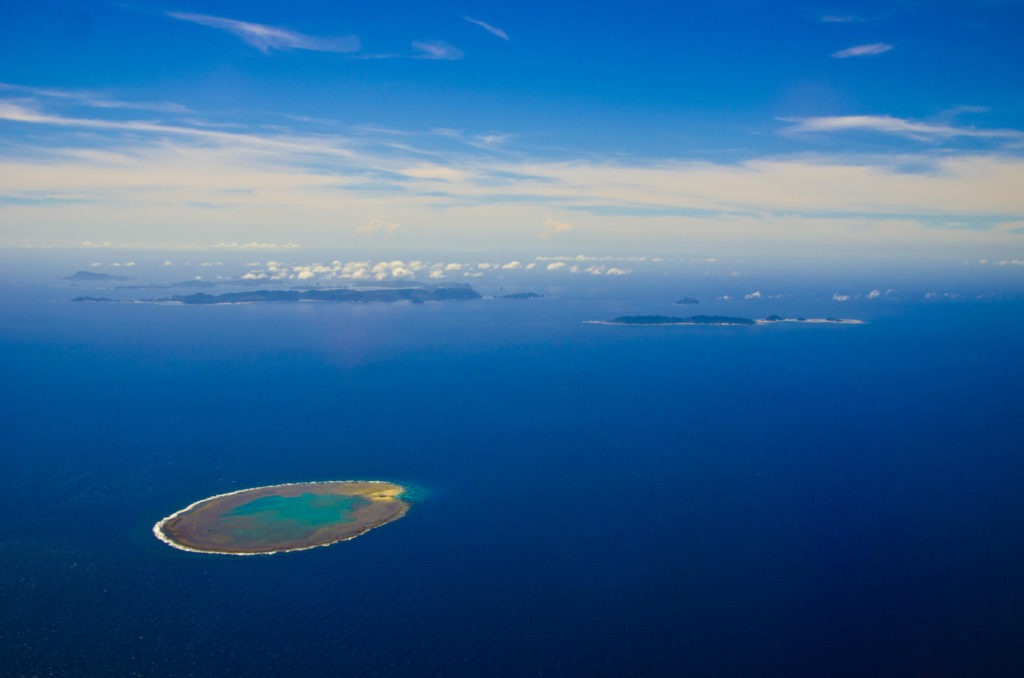
Forty-five minutes into the flight, deep ocean blues gradually gave way to the coral reefs of the Yaeyama Island chain passing underneath the jet. From the air, the ocean offerings appeared promising with long finger reefs, rocky cliffs and sandy beaches all tempting us from our lofty perch.
As we approached Ishigaki, we traversed the long eastern coastline before gliding over agricultural plots of sugar cane and rice and coasting in for a landing.
We were staying at the Hotel Nikko Yaeyama, a short drive from the airport and not far from the many lively restaurants, bars and shops in Ishigaki’s “downtown” area. After the friendly staff took our bags to our rooms, we headed back out to catch our first Ishigaki sunset.
Ishigaki isn’t a highly populated island. There are approximately 50,000 permanent residents, and people are friendly; perhaps even a bit shy. Stroll around the downtown area, and you’ll find small pubs and eateries lining the streets while kids play baseball or ride their bikes nearby.
Drive around, and you soon find no one is in any hurry to get where they are going; it’s a nice change of pace, and true island style.
The famous folk singer Rimi Natsukawa hails from here. She is known for the song, “Nada Sōsō” (“Great Tears are Falling”), based on an old Okinawan phrase. This hilly and lush island must also be good for bike riding as Tour De France rider Yukiya Arashiro is also an Ishigakian.
We watched the sun set from the top of the Ishigaki Port Bridge. Manta ray sculptures adorn this bridge, and you get the idea that diving tourism is both popular here and a staple part of the economy.
Ishigaki boasts more than 120 dive shops, and that’s a lot for a small place. But most are very small and personalized operations, so the seas aren’t really as crowded as one might think.
We chatted with a fellow traveler from Sendai enjoying her time exploring Ishigaki, as well as the nearby islands of Iriomote, Taketomi and Kohama. After the Tohoku earthquake on March 11, 2011, she had been understandably wary of the ocean. She decided to travel out to these islands during her college break to refresh and regain her love of the sea.
The next morning we were off to explore the sea ourselves. Our hosts for the first few days would be the fine folks at Diving School Umicoza. The shop is owned by one of the pioneers of Ishigaki diving, the friendly and unassuming Makoto Sonoda.
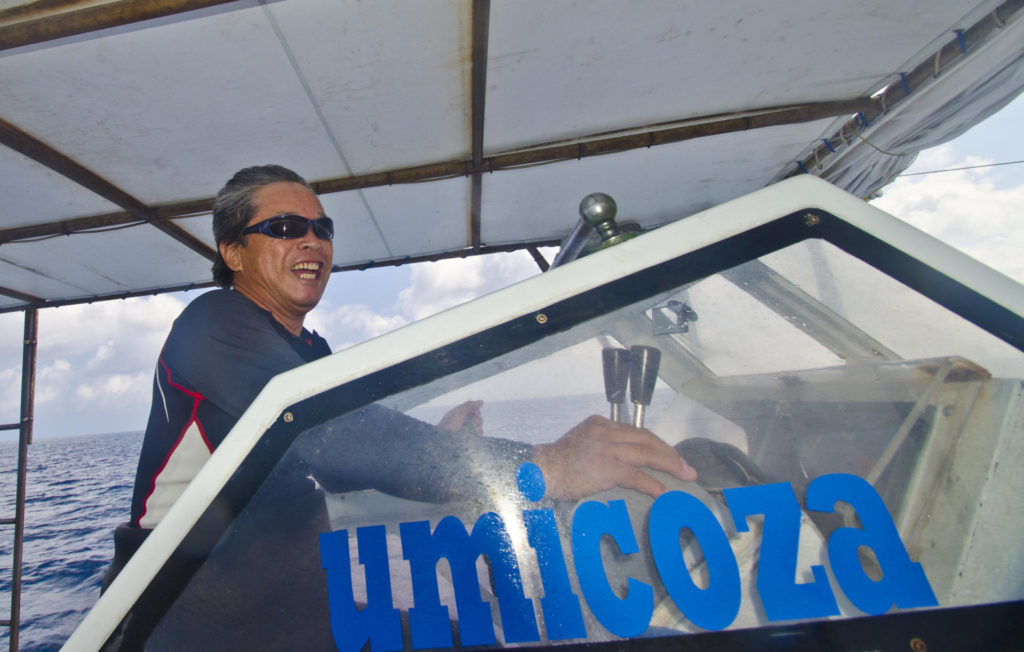
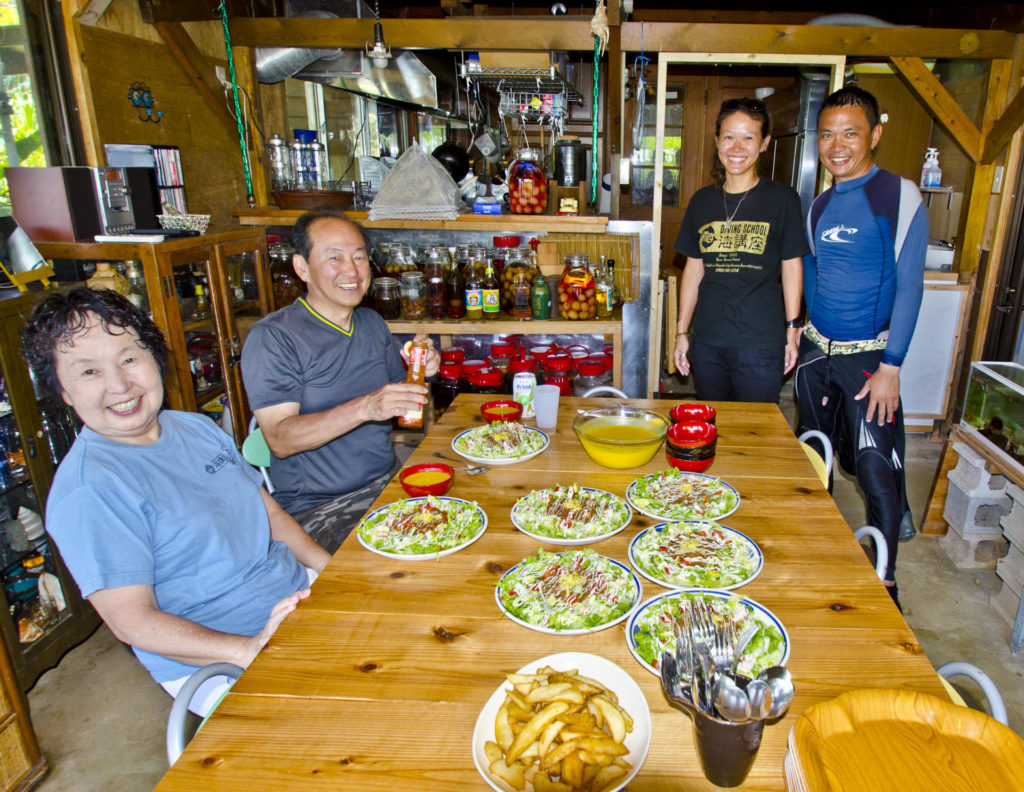
The first day we were picked up at the hotel by the friendly Mikiko “Miki” Ando and, when we arrived, we were greeted by an energetic international staff. The dive center has a wonderful western view atop a hill overlooking the famous and undeniably scenic Kabira Bay. From the shop’s grounds, it is just a five-minute drive through a tree-lined parkway down to Kabira Village and sandy Honifu Beach where the dive boats await.
Further down the beach is a marine park catering to groups who prefer the convenience of peering at the ocean from the safety of glass-bottom boats. Out of the bay, a turn to the left takes us to the manta dives and to the right are some exciting coral dives and diverse macro sites.
The world’s oceans and coral reefs have experienced a lot of turmoil in recent years, and those in the Okinawa area have not been immune to those problems. The Manta Scramble reefs, for instance, were beset with a crown-of-thorns starfish invasion. These starfish eat coral polyps.
While a natural occurrence that probably help reefs control dominant coral species, these outbreaks do leave the reefs looking pretty rough for a few years until the corals start to rebound.
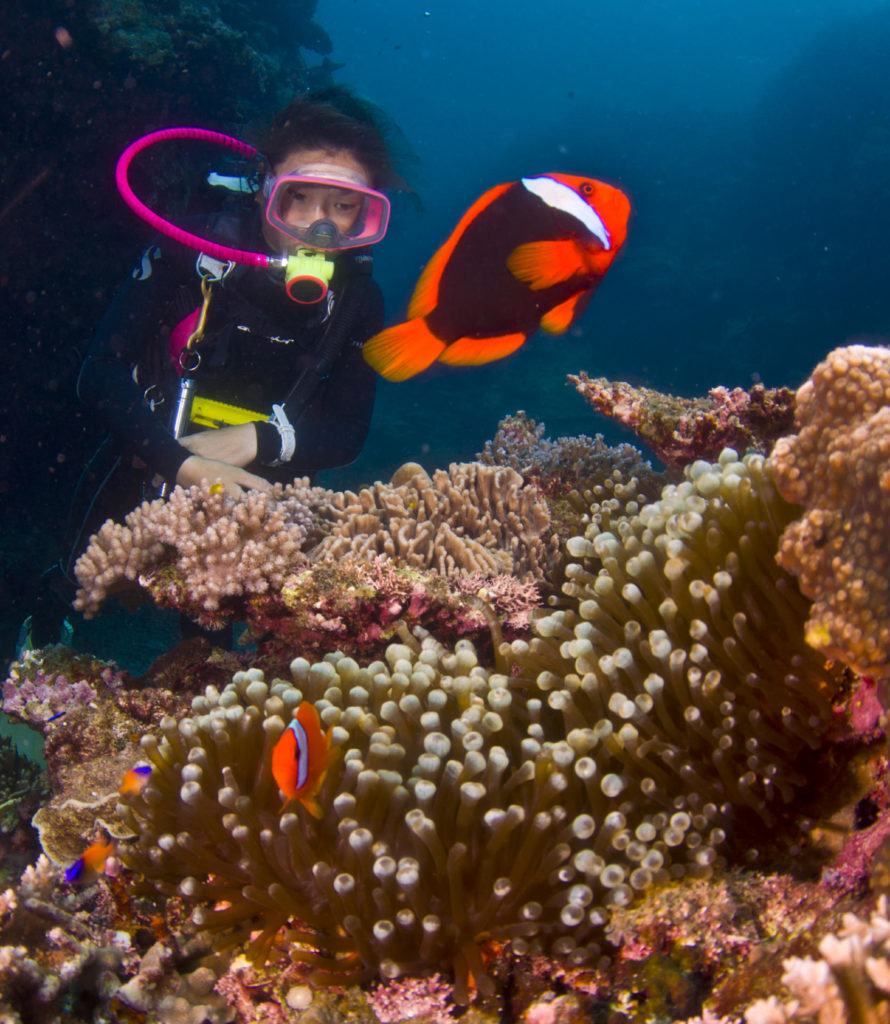
Typhoons also hit the island, the result of which can be seen in rubbly parts of the popular Yonehara diving area. But many other areas of the reefs here are thriving and healthy with everything from cruising tuna to tiny leaf fish, and just about everything in between.
There are at least 65 recognized dive sites spread across 19 islands that form the Yaeyama Island chain. Ishigaki’s configuration provides for varied conditions and spectacular diving opportunities in the various bays and points. Distances to dive sites vary but are normally no more than five to 15 minutes.
What is striking is the upper reef at many of the dive sites. Sprawling table corals mix with developing star and brain corals and form dense cover over reefs pocked with swim-throughs and small caves.
Beautiful leopard morays and other types of eels poke from these cracks. Sea snakes (curious and deadly if you are bitten, but quite gentle) roam in and out of the holes looking for shellfish and colorful nudibranchs to conceal themselves in the overhangs.
My divemaster Akiko “Ako” Kurashita was truly helpful as both fish finder and underwater model here. Gardner acted as our sea snake magnet. They must have liked the color of his fins.
Okinawa has a great many types of fish in its waters; perhaps 900 species or more. On one dive at Yonehara South, I saw five kinds of anemone fish (including Nemo) in one dive as well as varied anemones.
Clear shrimp live in the tentacles. Pufferfish are ubiquitous. The reefs are no deeper than 10 meters in most places and generally average about six or seven meters, so nice, long dives can be made. Photographers will delight in the light the clear waters allow.
After a break for some rewarding snorkeling, off-gassing and some tea, we headed over to Manta Scramble. When I asked about the name of the dive site, the response was simply, “You’ll see.” Indeed, it soon became apparent.
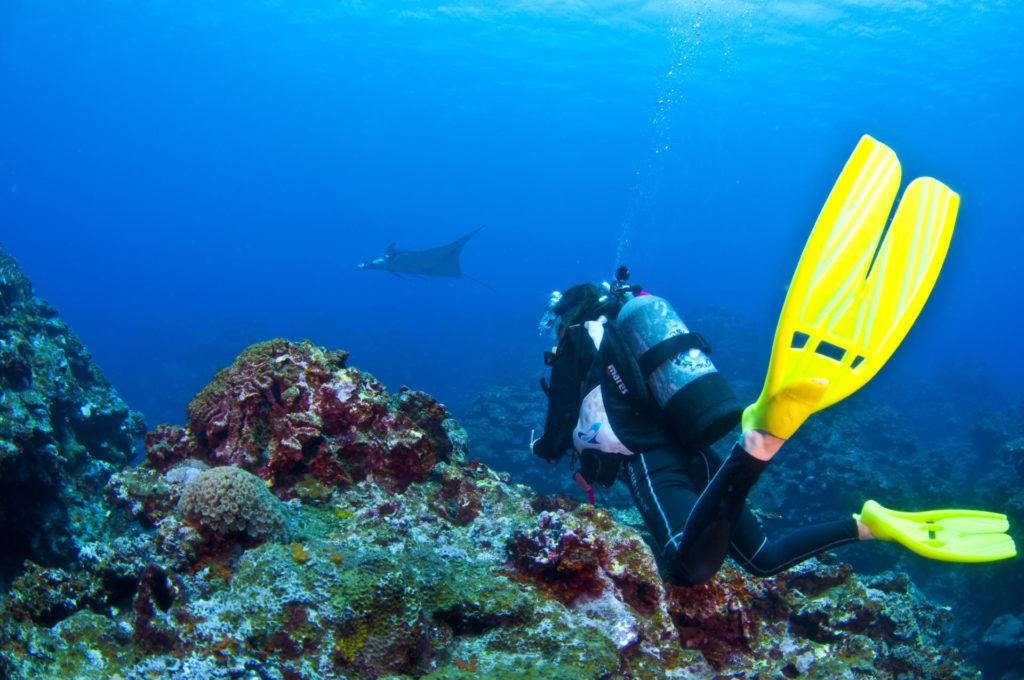
After my descent and the wonderful interaction to start my first Ishigaki manta dive, I took a look around. This site has lots of high-rise coral heads separated by deep valleys.
While the cleaning stations are located largely on the tops of these big coral structures, the deep valleys in between have divers moving slowly from one cleaning station to another, as the mantas move. It is a bit of an undersea scramble to get to a site and settle in so the manta isn’t disturbed.
Sometimes one can be caught in open sea with mantas flying gracefully by, as my dive buddy Gardner found on his first drop at the Scramble. He improvised quickly, stopping suspended and started video taping his manta companions with his GoPro.
The area also has quite a few sea anemones and fish. There is a bit of an open valley that leads to another shallower adjacent site called Manta Point. The images taken of mantas here on a sunny day can be breathtaking, as the sea filters the sun’s rays while the mantas cruise over the reef.
Nearby is another site that also makes a great photo backdrop. The Sakieda Big Arch, photographed at the right angle, can have a very dramatic lighting effect. Other swim-throughs in the site area also make this a fun dive.
After two boat dives, it was time to head back to Umicoza for lunch. The first day we were treated to tako sarada (Okinawan-style taco salad), and the next day it was famous Okinawan soba.
Fresh fruits and veggies and some nice tea made me want to take a nap, but there was a superb macrophotography site not far from Yonehara, so we headed off for a third afternoon dive.
At the site, dive shops had placed natural materials such as palm fronds at about 50 feet. These form artificial reefs to attract unusual fish and invertebrate life such as ornate ghost pipefish, frogfish, hawkfish and other desirable photo subjects.
Sea snakes and spotted stingrays hunt for food in the sand plain next to the aggregation pieces. I was aided by a veteran macro spotter, Umicoza’s Harvey Leong, a divemaster from Malaysia who also speaks Chinese which is helpful for the growing number of Taiwanese tourists in Ishigaki. All good photographers are made to look better with a good critter finder, and he had me shooting constantly.
Also in this area, unassuming cleaning stations are inhabited by invertebrates such as four cleaner shrimp species, mantis shrimps, blennies and gobies, pipefish and juvenile lionfish.


Swimming back toward the reef at this site, one can find clouds of glass fish and sweepers with the usual suspects nearby, ready to grab an easy meal. Big lion fish and coral groupers make this habitat their homes.
The rocks and wall here are also quite good for finding unusual and tiny nudibranchs. I had to break out my Aquatica diopter kit to photograph some of the very tiny and unusual nudibranchs.
The next day, we headed over to the posh Club Med Resort. Talk about location, location location…The house reef for Club Med is Manta Scramble/Manta Point. So a two-minute boat ride had us again mingling with mantas.
We spent the day at Manta Point with the friendly folks at Euro Divers. This international dive shop runs the diving out of Club Med, and my divemaster on the day, Eiko Basso-Ozaki, found schools of yellow goatfish and lots of other stuff. We had a good swim and tour of the area before a quick and easy boat ride back to the beach.
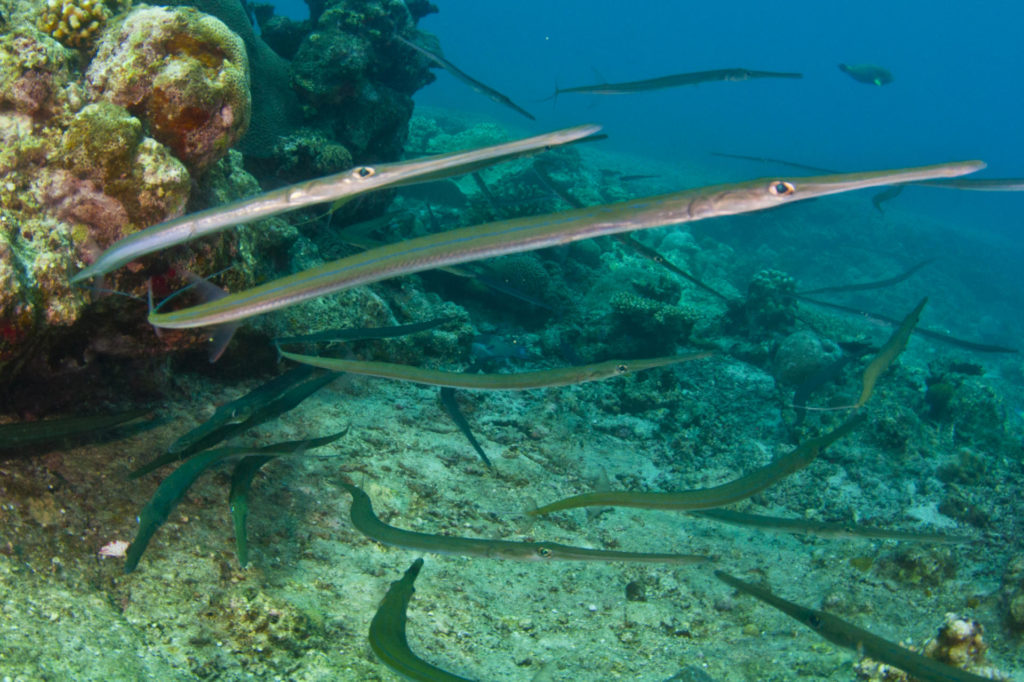
Here guests were enjoying a variety of water sports such as jet skis, sea kayaks, windsurfing and snorkeling. Others lounged in plush beach chairs under the shade of white parasols and enjoyed the view.
At night, Ishigaki Town where probably 90 percent of the island’s people live, is a delight. Restaurants serve Okinawa’s ubiquitous Orion beer on tap, sizzle up some rafute (Okinawan glazed pork) and serve very fresh teka maki (sushi rolls with raw tuna). There are gift shops that feature wonderful hand-made crafts as well.
Is there more to do besides diving and snorkeling on Ishigaki? Actually, there are tons of great outdoor things to do. Adventure seekers can paraglide off lofty cliffs or catch some air kite-surfing in empty reef bays, and there is even some great surfing during typhoon swells.
More relaxing fun can be had stand-up paddle-boarding or kayaking the rich mangroves and the inner reefs. Hit the open road on a touring bike or just peddle around town. You can even take a hike in the tropical forest or climb up Mt. Fukaiomoto.
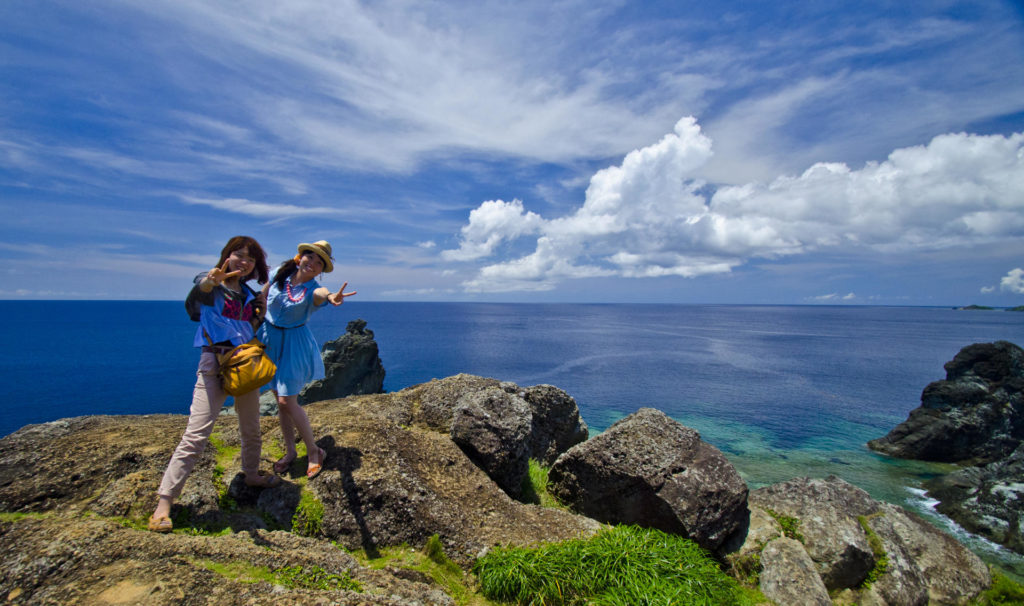
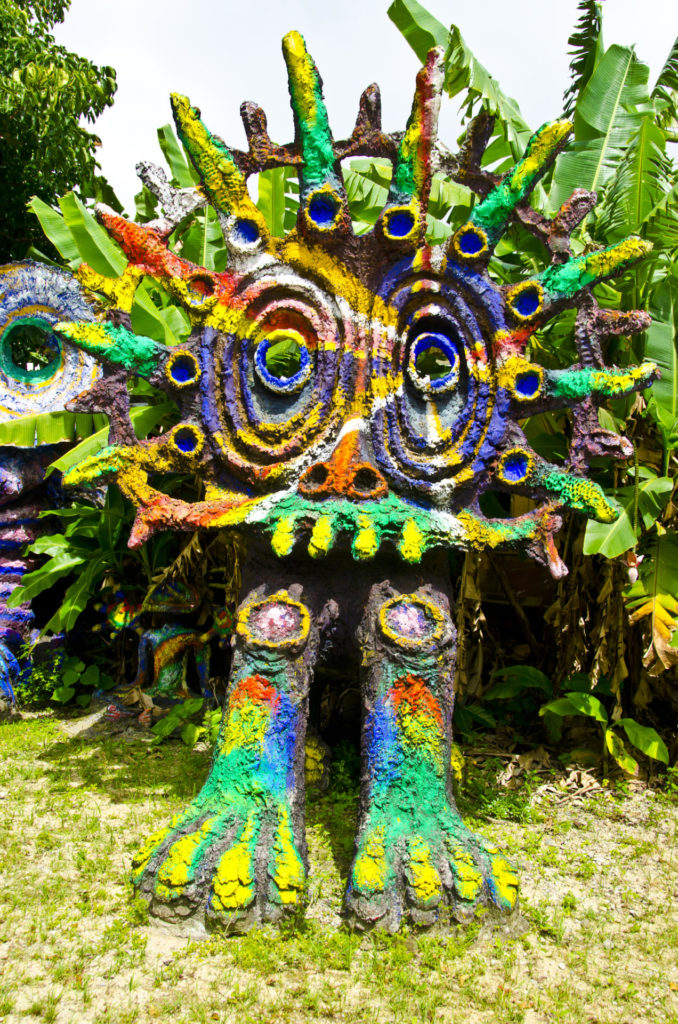
Uganzaki Lighthouse was one of the most breathtaking sites we visited, with a broad and beautiful coral bay on one side, beautiful rock canyons leading to the sea on another, and Mt. Yarabu hovering above.
One thing is for sure; we needed more time to investigate more. The island had it all, and we found we had just scratched the surface of adventure here. On our last day, we joined long-time Ishigaki resident Chikara Tsumura who took us to the north side of the island to Akaishi Beach, a two-mile stretch of sandy beach, totally undeveloped.
Here a large inner reef area is fed by a boiling cut in the reef. Blues and greens of the inner reef gave way to darker corals in an amazing setting and were the only ones there. As Tsumura-san skimmed across the water, I photographed him from the shore and marveled at the wild tranquility of the setting. Surf crashing, wind blowing and beauty reigning supreme. This was Ishigaki, above or below the water, a natural dreamland.




